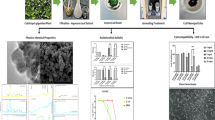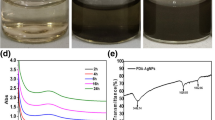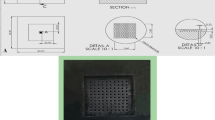Abstract
Skin substitutes are a restorative material used to treat many skin injuries by replacing or masking the wound. It is also capable of producing an original skin type. In this study, gold nanoparticle–aided skin substitutes were prepared using biodegradable materials (chitosan, sodium alginate, and gelatin) under the magnetic stirring method. Gold ions were reduced using aqueous extract of Cyperus rotundus and Hemigraphis alternata. The formation of prepared gold nanoparticles was confirmed using spectroscopy techniques. The physical parameters of the skin substitutes were tested, and it was characterized using FTIR, DTG, laser profilometer, and FESEM analysis. HAaNP-aided skin substitutes have a bubble-like texture, and it facilitates higher water-absorbing ability. CRaNP aided skin substitutes reducing the hydrophilicity of the prepared skin substitutes. Antioxidant and antifungal skin substitute activities were carried out using DPPH radical scavenging activity and disk diffusion method, respectively. The antioxidant activity revealed the skin substitutes to possess significant free radical inhibition and as the number of gold nanoparticles increases, the activity also increases. The prepared samples show excellent activity against Aspergillus niger. The MTT assay reveals that the cancer cell (A-375) viability decreases by increasing skin substitutes’ concentration. The normal cells (HEK-293) were cultured in a medium containing skin substitutes, facilitating the growth of cells. The cell attachment was observed in prepared cell lines after 24-h treatment. The results of this study suggest the prepared Cyperus rotundus and Hemigraphis alternata embedded with gold nanoparticle–aided skin substitutes are a promising material for medical and cosmetic application.















Similar content being viewed by others
Data availability
Not Applicable
References
Dolbashid, A. S., Mokhtar, M. S., Muhamad, F., & Ibrahim, F. (2017). Potential applications of human artificial skin and electronic skin (e-skin): A review. Bioinspired, Biomimetic and Nanobiomaterials, 7(1), 53–64. https://doi.org/10.1680/jbibn.17.00002.
Saurabh, D., Baganizi, D. R., Sahu, R., Dosunmu, E., Chaudhari, A., Vig, K., Pillai, S. R., Singh, S. R., & Dennis, V. A. (2017). Immunological challenges associated with artificial skin grafts: Available solutions and stem cells in future design of synthetic skin. Journal of Biological Engineering, 11(1), 49. https://doi.org/10.1186/s13036-017-0089-9.
Ferreira, M. C., Paggiaro, A. O., Cesar, I., Neto, N. T., Dos, G. B., & Santos. (2011). Skin substitutes: current concepts and a new classification system. Rev. Bras. Cir. Plast, 26(4), 696–702696.
Peng, Z., Deng, C., Xu, H., Xing, T., He, H., Lin, C., & Jiansheng, S. (2014). Fabrication of photo-crosslinked chitosan- gelatin scaffold in sodium alginate hydrogel for chondrocyte culture. Bio-medical Materials and Engineering, 24(1), 633–641. https://doi.org/10.3233/BME-130851.
Bapi, S., Raminder, S., Raquel, S., Roether, J. A., Joachim, K., Rainer, D., Schubert, D. W., Iwona, C., & Boccaccini, A. R. (2014). Evaluation of fibroblasts adhesion and proliferation on alginate-gelatin crosslinked hydrogel. PLoS One, 9(9), e107952. https://doi.org/10.1371/journal.pone.0107952.
Bhowmick, S., Thanusha, A. V., Kumar, A., Scharnweber, D., Rother, S., & Koul, V. (2018). Nanofibrous artificial skin substitute composed of mPEG–PCL grafted gelatin/hyaluronan/chondroitin sulfate/sericin for 2nd degree burn care: In vitro and in vivo study. RSC Advances, 8(30), 16420–16432. https://doi.org/10.1039/c8ra01489b.
Devi Pandima, M., Sekar, M., Chamundeswari, M., Moorthy, A., Krithiga, G., Selva Murugan, N., & Sastry, T. P. (2012). A novel wound dressing material— fibrin–chitosan–sodium alginate composite sheet. Bulletin of Materials Science, 35(7), 1157–1163.
Das Subhamoy, Aaron B Baker (2016) Biomaterials and nanotherapeutics for enhancing skin wound healing. Frontiers in Bioengineering and Biotechnology 4:82. DOI: https://doi.org/10.3389/fbioe.2016.00082
Morgane, B., Yves, G., Lacroix, C., Verrier, B., & Monge, C. (2017). Nanoparticle-based dressing: The future of wound treatment? Trends in Biotechnology, 35(8), 770–784. https://doi.org/10.1016/j.tibtech.2017.05.005.
Peng, C. C., Yang, M. H., Chiu, W. T., Chiu, C. H., Yang, C. S., Chen, Y. W., & Peng, R. Y. (2008). Composite nano-titanium oxide–chitosan artificial skin exhibits strong wound-healing effect—An approach with anti-inflammatory and bactericidal kinetics. Macromolecular Bioscience, 8(4), 316–327. https://doi.org/10.1002/mabi.200700188.
Wang, T., Zheng, Y., Shen, Y., Yijie, S., Fang, L., Chang, S., & Liang, Z. (2017). Chitosan nanoparticles loaded hydrogels promote skin wound healing through the modulation of reactive oxygen species. Artificial Cells, Nanomedicine, and Biotechnology, 46(sup1), 138–149. https://doi.org/10.1080/21691401.2017.1415212.
Hebbalalu, D., Lalley, J., Nadagouda, M. N., & Varma, R. S. (2013). Greener techniques for the synthesis of silver nanoparticles using plant extracts, enzymes, bacteria, biodegradable polymers, and microwaves. ACS Sustainable Chemistry & Engineering, 1(7), 703–712. https://doi.org/10.1021/sc4000362.
Nadagouda, M. N., & Varma, R. S. (2008). Green synthesis of silver and palladium nanoparticles at room temperature using coffee and tea extract. Green Chemistry, 10(8), 859. https://doi.org/10.1039/b804703k.
Nadagouda, M. N., & Varma, R. S. (2006). Green and controlled synthesis of gold and platinum nanomaterials using vitamin B2: Density-assisted self-assembly of nanospheres, wires and rods. Green Chemistry, 8(6), 516. https://doi.org/10.1039/b601271j.
Varma, R. S. (2012). Greener approach to nanomaterials and their sustainable applications. Current Opinion in Chemical Engineering, 1(2), 123–128. https://doi.org/10.1016/j.coche.2011.12.002.
Kou Jiahui, Rajender S Varma (2012) Beet juice utilization: Expeditious green synthesis of noble metal nanoparticles (Ag, Au, Pt, and Pd) using microwaves. RSC Advances 2(27):10283. https://doi.org/10.1039/c2ra21908e
Kou, J., & Varma, R. S. (2012). Beet juice-induced green fabrication of plasmonic AgCl/Ag nanoparticles. ChemSusChem, 5(12), 2435–2441. https://doi.org/10.1002/cssc.201200477.
Nadagouda, M. N., Iyanna, N., Lalley, J., Han, C., Dionysiou, D. D., & Varma, R. S. (2014). Synthesis of silver and gold nanoparticles using antioxidants from blackberry, blueberry, pomegranate, and turmeric extracts. ACS Sustainable Chemistry & Engineering, 2(7), 1717–1723. https://doi.org/10.1021/sc500237k.
Baruwati, B., Polshettiwar, V., & Varma, R. S. (2009). Glutathione promoted expeditious green synthesis of silver nanoparticles in water using microwaves. Green Chemistry, 11(7), 926. https://doi.org/10.1039/b902184a.
Baruwati, B., & Varma, R. (2009). High value products from waste: grape pomace extractâ. A Three-in-One Package for the Synthesis of Metal Nanoparticles. ChemSusChem, 2(11), 1041–1044. https://doi.org/10.1002/cssc.200900220.
Dipali, G., Singh, V., & Agrawal, N. (2016). Volatile constituents and antimicrobial activities of dried rhizome of Cyperus rotundus Linn. International Journal of Current Microbiology and Applied Sciences, 5(11), 334–339.
Gui-feng, H., Mao-qin, T., Yan-jin, W., Feng-yuan, C., & Li-ju, Q. (2017). Determination of antidepressant activity of Cyperus rotundus L extract in rats. Tropical Journal of Pharmaceutical Research, 16(4), 867–871.
Singh, S. P., Raghavendra, K., & Dash, A. P. (2009). Evaluation of hexane extract of tuber of root of Cyperus rotundus Linn (Cyperaceae) for repellency against mosquito vectors. Journal of Parasitology Research, 2009, 1–5. https://doi.org/10.1155/2009/908085.
Essaidiab, I., Koubaierab, H. B. H., Snoussiab, A., Casabiancac, H., Chaabouniab, M. M., & Bouzouita, N. (2014). Chemical composition of Cyperus rotundus L. tubers essential oil from the South of Tunisia, antioxidant potentiality and antibacterial activity against foodborne pathogens. Journal of Essential Oil-Bearing Plants, 17(3), 522–532. https://doi.org/10.1080/0972060X.2014.895182.
Ilham Eroz Poyraz, Betül Demirci, Sevim Kucuk (2018) Volatiles of Turkish Cyperus rotundus L. Roots, Rec. Nat. Prod. 12:3:222-228.
Raut, N. A., & Gaikwad, N. J. (2006). Antidiabetic activity of hydroethanolic extract of Cyperus rotundus in alloxan induced diabetes in rats. Fitoterapia, 77(7-8), 585–588.
Puratchikody, A., Devi, C. N., & Nagalakshmi, G. (2006). Wound healing activity of Cyperus rotundus linn. Indian Journal of Pharmaceutical Sciences, 68(1), 97–101.
Yu, H.-H., Lee, D.-H., Se-Jeong, S., & Yong-Ouk, Y. (2007). Anticariogenic properties of the extract of Cyperus rotundus. The American Journal of Chinese Medicine., 35(3), 497–505.
Edwin, B. T., & Nair, P. D. (2011). In vitro evaluation of wound healing property of Hemigraphis alternata (Burm. F) t. Anderson using fibroblast and endothelial cells. Biosciences, Biotechnology Research Asia, 8(1), 185–193.
Annapoorna, M., Sudheesh Kumar, P. T., Lakshmi, R., Lahshman, Lakshman, V. K., Nair, S. V., & Jayakumar, R. (2013). Biochemical properties of Hemigraphis alternate incorporated chitosan hydrogel scaffold. Carbohydrate Polymers, 92, 1561–1565. https://doi.org/10.1016/j.carbpol.2012.10.041.
Rahman Mushiur, S. M., Atikullah, Islam, N., Mohaimenul, Ahammad, F., Islam, S., Saha, B., & Rahman, H. (2019). Anti-inflammatory, antinociceptive and antidiarrhoeal activities of methanol and ethyl acetate extract of Hemigraphis alternata leaves in mice. Clinical Phytoscience, 5, 16. https://doi.org/10.1186/s40816-019-0110-6.
Yang, D. S., Svoboda, V., Son, K.-C., & Kays, S. J. (2009). Screening indoor plants for volatile organic pollutant removal efficiency. Hortscience, 44(5), 1377–1381.
Forester, S. C., & Lambert, J. D. (2011). Antioxidant effects of green tea. Molecular Nutrition & Food Research, 55(6), 844–854. https://doi.org/10.1002/mnfr.201000641.
Wani, S. A., & Kumar, P. (2018). Fenugreek: A review on its nutraceutical properties and utilization in various food products. Journal of the Saudi Society of Agricultural Sciences, 17(2), 97–106.
Nayak, A. K., Pal, D., Pradhan, J., & Hasnain, M. S. (2013). Fenugreek seed mucilage-alginate mucoadhesive beads of metformin HCl: Design, optimization and evaluation. International Journal of Biological Macromolecules, 54, 144–154. https://doi.org/10.1016/j.ijbiomac.2012.12.008.
Shahed, P., Rahman, M., Khan, M. A., Khan, A. H., Islam, J. M. M., Ahmad, M., Fizur Rahman, M., & Ahmed, B. (2012). Preparation and characterization of artificial skin using chitosan and gelatin composites for potential biomedical application. Polymer Bulletin, 69(6), 715–731. https://doi.org/10.1007/s00289-012-0761-7.
Wu, J., Liu, H., Shuang Wang, G. S., Qin, Z., Chen, L., Zheng, Q., Liu, Q., & Zhang, Q. (2015). The preparation, characterization, antimicrobial stability and in-vitro release evaluation of fish gelatin films incorporated with cinnamon essential oil nanoliposomes. Food Hydrocolloids, 37, 166–173.
Yunzhen, Y., Ding, D., Hongyuan, S., Qifan, P., & Yaqin, H. (2017). Antibacterial activity and physical properties of fish gelatin-chitosan edible films supplemented with D-limonene. International Journal of Polymer Science, 2017, 1–9. https://doi.org/10.1155/2017/1837171.
Kavoosi, G., Dadfar, S. M. M., Mohammadi Purfard, A., & Mehrabi, R. (2013). Antioxidant and antibacterial properties of gelatin films incorporated with carvacrol. Journal of Food Safety, 33(4), 423–432. https://doi.org/10.1111/jfs.12071.
Masoumeh, E., Safavipour, H., Houshmand, B., & Faghihi, S. (2018). Development of a PCL/gelatin/Chitosan/β-TCP electrospun composite for guided bone regeneration. Progress in Biomaterials, 7(3), 225–237. https://doi.org/10.1007/s40204-018-0098-x.
Sasidharan, S., & Pottail, L. (2019). Antimicrobial activity of metal and non-metallic nanoparticles from Cyperus rotundus root extract on infectious disease-causing pathogens, Journal of Plant Biochemistry and Biotechnology. Journal of Plant Biochemistry and Biotechnology, 29, 134–143. https://doi.org/10.1007/s13562-019-00523-1.
Santhiya, S., & Pottail, L. (2020). Anti - bacterial and skin - cancer activity of AuNP, rGO and AuNP - rGO composite using Hemigraphis alternata (Burm. F.) T. Anderson. Biocatalysis and Agricultural Biotechnology, 25, 101596. https://doi.org/10.1016/j.bcab.2020.101596.
Shanthi, J., Aishwarya, S., & Swathi, R. (2020). Fabrication of roughness enhanced hydrophobic coatings. Journal of Nano- and Electronic Physics, 12(2), 02042. https://doi.org/10.21272/jnep.12(2).02042.
Sarangan, P., Jayakumar, K., & Jayashree, V. (2016). Primary cutaneous aspergillosis- tinea pedis caused by aspergillus niger in an immunocompetent adult individual residing in silk city of Kancheepuram district. International Journal of Advanced Research, 4(9), 443–446. https://doi.org/10.21474/IJAR01/1812.
Nirmala, D., & Kakati, D. K. (2013). Smart porous microparticles based on gelatin/sodium alginate polyelectrolyte complex. Journal of Food Engineering, 117, 193–204.
Mallikarjuna, B., Madhusudana Rao, K., Pallavi, K., Chowdoji Rao, K., & Subha, M. C. S. (2015). Biodegradable interpenetrating polymer network hydrogel membranes for controlled release of anticancer drug. Asian Journal of Pharmaceutical, 9, 129–136.
Cheng, Y.-H., Yang, S.-H., Wen-Yu, S., Yu-Chun, C., Yang, K.-C., Cheng, W. T.-K., Wu, S.-C., & Lin, F.-H. (2010). Thermosensitive chitosan–gelatin–glycerol phosphate hydrogels as a cell carrier for nucleus pulposus regeneration: An in vitro study. Tissue Engineering Parts A, 16(2).
Acknowledgements
The authors sincerely thank Avinashilingam Institute for Home Science and Higher Education for Women, for providing support and infrastructure to carry out this work. Our special thanks to Bharat Ratna Prof. CNR RAO Research Centre and Advanced Research Laboratory, AIHSHEW, Coimbatore, Tamilnadu, India, for providing characterization facilities.
Author information
Authors and Affiliations
Contributions
The first author (Santhiya Sasidharan): Design, methodology, writing-original draft preparation, and editing
The second author (Lalitha Pottail): Conceptualization, design, supervisor, manuscript review, and editing
Corresponding author
Ethics declarations
Ethics Approval
Not Applicable
Consent to Participate
Not Applicable
Consent for Publication
Not Applicable
Competing Interests
The authors declare no competing interests.
Additional information
Publisher’s Note
Springer Nature remains neutral with regard to jurisdictional claims in published maps and institutional affiliations.
Rights and permissions
About this article
Cite this article
Sasidharan, S., Pottail, L. Biodegradable Polymers and Gold Nanoparticle–Decorated Skin Substitutes: Synthesis, Characterization, and In Vitro Biological Activities. Appl Biochem Biotechnol 193, 3232–3252 (2021). https://doi.org/10.1007/s12010-021-03600-1
Received:
Accepted:
Published:
Issue Date:
DOI: https://doi.org/10.1007/s12010-021-03600-1




